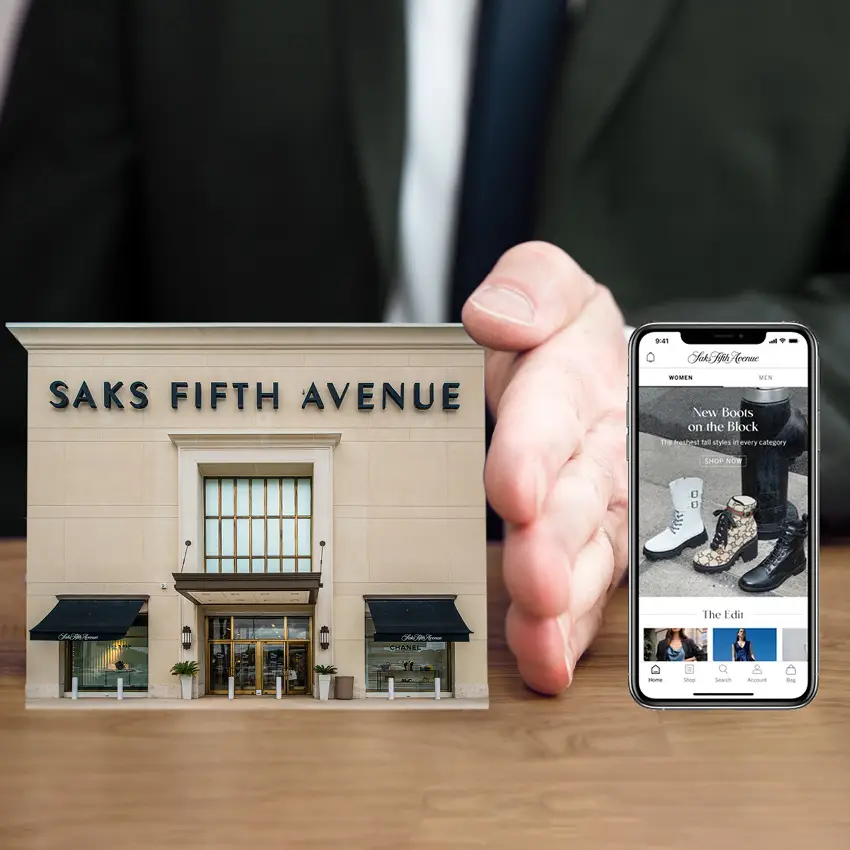I will state my opinion right up front. I believe Richard Baker\’s move to split the Saks Fifth Avenue and its ecommerce business into separate companies, which he calls \”unlocking value,\” is simply applying a fancy buzzword, disguising what will ultimately lead to a real estate play. The reality is somewhere, way down deep in his real estate DNA, he clearly sees his personal cash-generating machine where it always has been — in real estate. So, don\’t fall for unlocking value in the retail enterprise as a strategy to improve and accelerate the growth of the retail business.
Tracking Two Moguls Veiled as Retailers
I\’ve had fun over the past couple of decades, first covering Eddie Lampert\’s publicly declared intention to return Sears and Kmart to the iconic and powerful brands they once were, and the second, covering Richard Baker\’s acquisition of Saks Inc. and Lord & Taylor, adding those two brands to HBC, already under his ownership. Baker also declared that he would create synergies that would re-energize Saks and save the sinking L&T business. Neither has happened.
I have given Richard Baker and Eddie “Fast Buck” Lampert well-deserved kudos for their enormous success. And I have respected their integrity when up front and publicly, they both were promising to polish, spiff up and generally return the retail brands to greatness. But then I began to observe how over a fairly short period of time there was not a smidgeon of evidence that any of their brands had been improved, and certainly not re-energized
According to Shelley Kohan, our CSO, professor at FIT and a Saks alum, \”Saks is plagued by its own history and I lived through some of it personally during the mid-2000s. Over the past two decades, the company has really failed to deliver a unique value proposition to its target market and has kept shifting its strategy. It wasn\’t until Steve Sadove became the Chairman and CEO of Saks Inc. in 2006 that the company actually seemed to run efficiently. He departed in 2013 upon HBC\’s acquisition of Saks, and Richard Baker has been the acting chief since then, even though several CEOs have come and gone. In my opinion, the demise of L&T and Saks Inc.\’s slow to no growth performance (other than spiffing up the Saks Fifth Avenue flagship) is now exacerbated by splitting up the brick-and-mortar and online businesses. This is not a good omen for success. And If there is one thing we have learned since the boom of ecomm, it\’s that the business should be run holistically not siloed.\”
The fun part of my tracking these two moguls was challenging myself to learn more about the audacious moves by two audacious outsiders whose credentials and roots were similar. They are brilliant in figuring out how to make a lot of money, but both are grounded in, and driven by their brilliance in other professions–neither of them has one iota of experience in retailing.
Real Estate Posing as Retail
I have written extensively about Eddie \”Fast Buck\” Lampert, and more recently, Richard Baker. (see links at the end of this article)
Richard Baker built a multibillion-dollar real estate business as NRDC Equity Partners and Eddie Lampert built his multibillion-dollar investment firm, ESL Investments, and continues to own Sears and Kmart, rebranded as Sears Holdings.
I have given them well-deserved kudos for their enormous success. And I have respected their integrity when up front and publicly, they both were promising to polish, spiff up and generally return the retail brands to greatness. But then I began to observe how over a fairly short period of time there was not a smidgeon of evidence that any of their brands had been improved, and certainly not re-energized.
Sears on the Edge
Sears, of course, is not only on the edge of the abyss, there is no lifeline to save it. Think about it. When Eddie realized he could not return it to greatness, he defaulted to what he is brilliant at doing: financial engineering. So, in a word (and in the tons of articles I wrote), he managed to financially engineer the brand, down and soon to be out, over a decade and a half of moving the deck chairs around, leaving the Titanic to sink, while he brilliantly sailed away in a lifeboat along with tons of cash.
One of his most important, if not his only engineering strategy, was to \”unlock value.\” He securitized brands like Kenmore, Die-Hard, Craftsman and others, and combined them under a new entity, separate from Sears. The idea was to sell the brands as a wholesaler to other retailers, and ultimately to sell the brands to another acquirer. Then he formed a REIT to acquire Sears real estate to lease back to the operating stores. The result? The escalating leases slowly bled the retailer to death. More good news for Lampert? In the end, the real estate could also be sold as yet another value-unlocking move. For him, not Sears.
So, unlocking value is just a quick euphemism for separating all of the assets and placing a value on each that ultimately makes the sum of the parts more valuable than the whole, at the expense of the brand.
Is Richard Baker Using Lampert\’s Playbook?
It was recently announced that HBC (under Baker\’s ownership) will split the Saks Fifth Avenue fleet of some 40 stores and saksfifthavenue.com into separate companies. A venture capital and PE firm, Insight Partners, invested $500 million in the Saks ecommerce business, valuing it at $2 billion. With Insight\’s investment, suggesting a future run on an IPO, one could say that this move is indirectly unlocking value, ostensibly by increasing the value of the two separate parts, that when combined together, will be higher than the integrated whole.
Baker was quoted in a recent WWD article, \”This is just early days for online shopping, especially in luxury. There is an opportunity for luxury to triple its size online. No one really knows how retailing is going to play out. With this move, we are redefining the luxury shopping ecosystem. The transaction with Insight Partners reinforces HBC\’s ability to unlock significant value within our company\’s assets.\”
Maybe. But retailers more successful than any of his properties (read: Target, Walmart, Nordstrom and even Amazon who is accelerating in its brick-and-mortar expansion) all know \”how retail is going to play out,\” because they are charting their own futures, constantly led by consumers who are calling the shots. In fact, everybody in the industry whose heads have not been stuck in the sand know that success in the future depends on a seamless and totally integrated store and online business, as one holistic ecosystem.
So, Baker\’s other comment about this move unlocking significant value \”within our company\’s assets,\” is sooo Eddie \”fast cash\” Lampert\’s playbook, it makes my teeth hurt. As I said, Baker as an acknowledged mastermind of real estate now understands the horrifically challenging retail business, and he has not been able to significantly move the needle. In fact, he has failed to hardly move it at all in his retail holdings. Conceding the point, in one of WWD\’s Retail Summits, Baker was interviewed on stage and said just that — retail is incredibly tough, real estate not so much. Does this suggest Baker was inching ever closer to his default strategy, \”Richard Baker is my name, real estate is my game?\”
Richard\’s Own Playbook
Okay, to be fair, Baker does have his own playbook, but it sounds awfully familiar. I believe this Saks split up veils the true Baker strategy of unlocking value by somehow linking it all to real estate deals — like REIT moves — and buying or selling, and/or eventually monetizing all of the assets.
Again, my kudos to Richard and Eddie, not for their retail acumen and implementation of successful turnarounds, but for their brilliance in their fields of expertise, which is exactly where they should have stayed.
Previous Articles on Richard Baker and Eddie Lampert
[grid content=\”post\” tags=\”16417,16418\” number=\”8\” align=\”center\” gutter=\”xs\” show=\”title,more_link,image\” image_size=\”one-fourth\” slider=\”false\” width=\”xl\” columns=\”4\” boxed=\”true\” title_wrap=\”h6\” class=\”lampert\”]




